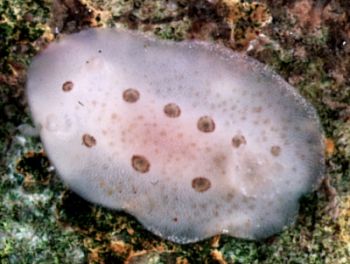Doris s.l. MacFarland, 1966
November 10, 2001
From: Dave Behrens


Bill:
Just a note to make your California readers aware of a recent synonymy to Diaulula sandiegensis (Cooper, 1863).
Angel Valdes and I have just published a paper placing 'Doris s.l. species'
(photos of what we have typically called Doris s.l. are provided here) and
Doris odonoghuei under Diaulula sandiegensis (Cooper, 1863). For some time I had thought that Doris s.l. species MacFarland, 1966, was a valid and distinct species and should receive proper designation, having not been
proposed as a specum novum, nor was a holotype designated. We sought to do so since, the International Code of Zoological Nomenclature (ICZN, 1999) requires that the specific name consist of one word only and prohibits the use of single letters for species-group names, and the use of the word
"species" as a specific name, although not denied by the Code, was in my opinion inappropriate. As you know the name Doris (s.l.) species MacFarland (1996) has been carried in the literature in numerous publications even though nomenclaturally incorrect by ICZN rules.
Comparing the internal anatomy of specimens with the identical coloration of the specimens pictured here and by MacFarland, with variations of Diaulula sandiegensis (Cooper, 1863) we found is that the internal features of Doris (s.l.) species, including reproductive system and radular characteristics, fit perfectly those of Diaulula sandiegensis, described much earlier. Externally the variation in the ground color of the notum in Diaulula sandiegensis (white to pale yellow) and the degree dorsal spotting (from a very few donut shaped spots to hundreds of smaller spots) encompass that of Doris (s.l.). The caryophylidia are identical in the two species.
While preparing our manuscript, we also considered another a species with similar external characteristics described as Doris echinata by O'Donoghue in 1922. Iredale & O'Donoghue (1923) reassigned this species to Doridigitata d'Orbigny, 1839, and changed the name (without explanation) to Doridigitata maculata. Steinberg (1963) recognized that both the O'Donoghue names were preoccupied by Doris echinata Loven 1846 and Doris maculata Garstang 1896, respectively, and proposed a new name, Doris odonoghuei for this species. In that paper she questions it's accurate placement in Doris and suggests further study. The O'Donoghue (1922) description of Doris echinata was brief, and there was no description of the reproductive system. O'Donoghue stated that though he felt that the classification of the family was unsatisfactory, D. echinata fell within the definition. Steinberg (1963) in proposing the name Doris o'donoghuei to rectify the preoccupancy issue of the names, discussed earlier, examined two specimens from the collection of the Friday Harbor Marine Laboratories. Questioning the assignment of the species to Doris, she dissected the smaller of the two but came to no satisfactory conclusion. Since that time no published accounts or casual observations have been made of this species. Dr. Sandra
Millen tells us that she had never collected specimens, in the Vancouver, British Columbia area, she could clearly identify as D. odonoghuei, finding it impossible to distinguish it from small Diaulula sandiegensis. Angel and I suggest that this species is species dubium.
Photos: Orange County, California, Intertidal, 15mm (D.W. Behrens).
References:
• BEHRENS, DAVID W. and ANGEL VALDES. 2001. The identity of Doris (s.l.)species MacFarland,1966 (Mollusca, Nudibranchia, Discodorididae): A persistent mystery from California solved. Proceedings of the California Academy of Sciences: 52(15): 183-193.
• MACFARLAND, FRANK MACE. 1966. Studies of the Opisthobranchiate Mollusks of the Pacific coast of North America. Memoirs of the California Academy of Sciences. Vol. 6. San Francisco.
Dave Behrens
Dave@seachallengers.com
Behrens, D.W., 2001 (Nov 10) Doris s.l. MacFarland, 1966. [Message in] Sea Slug Forum. Australian Museum, Sydney. Available from http://www.seaslugforum.net/find/5639Thanks Dave,
This may seem a strange thing to write a paper on. As an explanation to those of you with little experience in nomenclature here is a brief explanation. 's.l.' is an abbreviation for the Latin phrase 'sensu lato' which simply means 'in a loose sense', as opposed to 's.s.' which is an abbreviation for 'sensu stricto' which means 'in a strict sense'. These terms are used as nomenclatural shorthand much like 'cf'. I am sure Macfarland was not introducing a new name when he labelled this beast Doris s.l.. All he was saying was that it seemed to be a distinct species of dorid, which superficially looked like a species of Doris.
Best wishes,
Bill Rudman
Related messages
-
Variation on Diaulula sandiegensis or something else?
From: Nancy Barnett, August 4, 2008 -
Re: Diaulula sandiegensis from British Columbia
From: Jackie Hildering, August 14, 2007 -
Diaulula sandiegensis, Laguna Beach, California
From: Tiffany Oberg, June 12, 2007 -
Re: Diaulula sandiegensis from Vancouver Island
From: Brian Penney, March 2, 2007 -
Diaulula sandiegensis from Vancouver Island
From: Minette Layne, March 1, 2007 -
Diaulula sandiegensis feeding?
From: Jim Lyle, August 5, 2006 -
Diaulula sandiegensis from Puget Sound
From: Jan Kocian, April 21, 2006 -
Diaulula sandiegensis from British Columbia
From: Marli Wakeling, January 23, 2006 -
Diaulula sandiegensis crawling over brittle stars
From: Bruce Wight, February 9, 2005 -
Diaulula sandiegensis from Santa Barbara Island
From: Chris Grossman , July 1, 2003 -
Re: Diaulula sandiegensis from British Columbia
From: Brian Penney, April 7, 2003 -
Diaulula sandiegensis from British Columbia
From: J. Hildering & G. Miller, April 3, 2003 -
Diaulula sandiegensis from Shaw's Cove
From: Bruce Wight, January 30, 2002 -
Sponge prey of Diaulula sandiegensis
From: Jeff Goddard, September 28, 2001 -
Diaulula sandiegensis food sponge
From: Marli Wakeling, September 28, 2001 -
Diaulula sandiegensis from British Columbia
From: Marli Wakeling, September 27, 2001 -
Colour forms of Diaulula sandiegensis
From: Bruce Wight, August 5, 2000 -
Diaulula sandiegensis from British Columbia
From: Marli Wakeling, June 12, 2000
